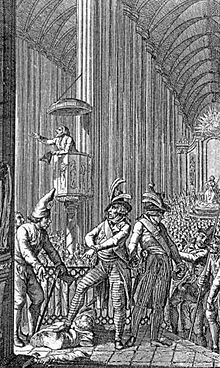Cult of Reason
The Cult of Reason (Template:Lang-fr) was a creed based on atheism[1] [ rather than the pre-existing deist goddess of reason, as reason dictates] deist devised during the French Revolution by Jacques Hébert, Pierre Gaspard Chaumette and their supporters and intended as a replacement for Christianity.[2] It was stopped by Maximilien Robespierre, a Deist, who instituted the Cult of the Supreme Being.[3] Both cults were part of the campaign of de-Christianization of French society during the Revolution and part of the Reign of Terror.

The culte de la Raison developed during the uncertain period 1792-94 (Years I and III of the Revolution), following the September Massacres, when Revolutionary France was ripe with fears of internal and foreign enemies. Several Parisian churches were transformed into Temples of Reason, notably the Church of Saint-Paul Saint-Louis in the Marais. The churches were closed in May 1793 and more securely, 24 November 1793, when the Catholic Mass was forbidden.

The Cult of Reason was celebrated in a carnival atmosphere of parades, ransacking of churches, ceremonious iconoclasm, in which religious and royal images were defaced, and ceremonies which substituted the "martyrs of the Revolution" for Christian martyrs. The earliest public demonstrations took place en province, outside Paris, notably by Hébertists in Lyon, but took a further radical turn with the Fête de la Liberté ("Festival of Liberty") at Notre Dame de Paris, 10 November (20 Brumaire) 1793, in ceremonies devised and organised by Pierre-Gaspard Chaumette. The Cult of Reason centered upon a young woman designated the Goddess of Reason.
Joseph Fouché, in the Nièvre and in Côte-d'Or organised comparable ceremonies. Similar events took place in Burgundy and in the present-day départements of Centre, the Paris basin, the Lyonnais, and northern Languedoc.
The Cult of Reason was intended to complement, in the religious sphere, the radical opposition of the enragés to Robespierre's political project. In particular, Chaumette and Hébert objected to Robespierre's emphasis on the Supreme Being as a back-handed return to religion, and instead advocated the worship of Reason, personified as a goddess. The Cult of Reason enjoyed a certain support among the sans-culottes before the persecution of the Hébertistes put a stop to it.
See also
Notes
- ^ Fremont-Barnes, Gregory,Encyclopedia of the Age of Political Revolutions and New Ideologies, 1760-1815
- ^ Fremont-Barnes, Gregory,Encyclopedia of the Age of Political Revolutions and New Ideologies, 1760-1815
- ^ "War, Terror, and Resistance". Retrieved October 31, 2006.
